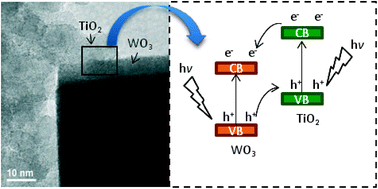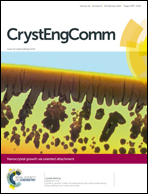WO3/TiO2 heterostructures tailored by the oriented attachment mechanism: insights from their photocatalytic properties†
Abstract
Efficient WO3/TiO2 photocatalysts were obtained through the Oriented attachment mechanism via hydrothermal annealing, which entailed using previously prepared WO3 particles and commercial TiO2 nanoparticles as “building blocks”. The photoreactivity of this material towards organic contaminant degradation was enhanced compared to commercial TiO2 because the coupling of the WO3/TiO2 structures reduced the recombination of the photogenerated charges in anatase TiO2. The pristine WO3 nanoparticles were prepared by hydrothermally assisted degradation of a W-peroxocomplex and all of the prepared materials were characterized by X-ray diffraction, Raman spectroscopy, thermogravimetric analysis, electron microscopy, Near-Infrared spectroscopy, nitrogen physical adsorption (BET method), photoluminescence spectroscopy (PL) and diffuse reflectance spectra (DRS). The optimal compositional ratio for the WO3/TiO2 heterostructures was 30–40 wt% of WO3. We also provided the interface formation in the HRTEM images by observing the presence of the lattice spacing of the (101) and (120) planes of TiO2 anatase and WO3 orthorhombic crystals, respectively, which allows the charge migration during the photocatalyzed degradation of the heterostructures, thereby improving their photoactivity.

- This article is part of the themed collection: Nanocrystal growth via oriented attachment

 Please wait while we load your content...
Please wait while we load your content...